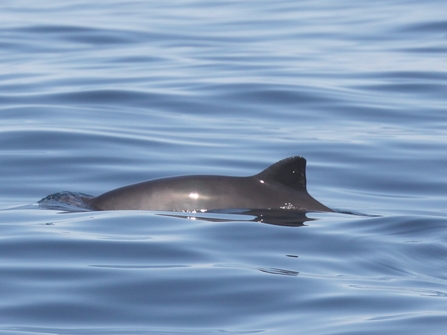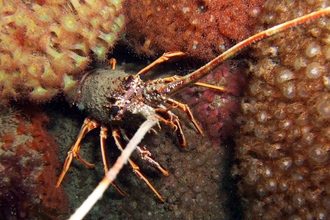This region stretches from Yorkshire's Flamborough Head down to mid Kent. With an extra 5 designations in 2019 there are now 11 existing Marine Conservation Zones in this area.
Existing Marine Conservation Zones
There have been 11 Marine Conservation Zones designated in the Southern North Sea so far.
Medway Estuary
This site has been designated for a range of estuarine habitats as well as for the tentacled lagoon worm, which lives in the narrow channels upstream of this dynamic estuary.
The sheltered muddy gravels in the area support some of the most diverse communities of animals in the region, providing rich nursery grounds for many fish, including skates, sea trout and an unusual sub-species of herring.
The mosaic of habitat types also includes saltmarsh islands and banks and mudflats, which contain many molluscs, worms and crustaceans that live within the sediment.
The area is also frequented by seals which haul out on the estuary banks and seabirds which forage for food in the rich muddy sediment.

Contains UKHO Law of the Sea data. Crown copyright and database right and contains Ordnance Survey Data Crown copyright and database 2012

Grey seal ©Chris Gomersall/2020VISION
Thanet Coast
This site has been designated for a wide range of habitats found in the area including sand, chalk, rock, peat and clay and gravel habitats, as well as to protect the ross worm reefs and two species of extraordinary and rare stalked jellyfish found here.
Thanet has the longest continuous stretch of coastal chalk in the UK. Its magnificent cliffs stand above the rich chalk reefs which stretch out across the shore and far out into the sea. The chalk shore features many gullies and supports lush seaweed assemblages, rich mussel beds and reefs made from the sandy tubes of industrious ross worms.
In the many rockpools, prawns, hermit crabs and small fish are regular sights, while specialities such as stalked jellyfish, brightly coloured sea slugs and little cuttlefish can also be found. On the chalk below the tide, colourful sponges, anemones and sea squirts abound, along with a variety of crab and fish species.
A breeding population of the stalked jellyfish St John’s Jellyfish (Lucernariopsis cruxmelitensis) was recorded beside Walpole Bay in September 2011 (photographed and filmed by the BBC). A video can be viewed here.

Contains UKHO Law of the Sea data. Crown copyright and database right and contains Ordnance Survey Data Crown copyright and database 2012

Little cuttlefish © marknthomasimages.co.uk
The Blackwater, Crouch, Roach and Colne Estuaries
This site was designated in 2013 to protect the intertidal sediment habitats found here, as well as to provide protection for the native oyster beds.
Located as part of the wider Outer Thames Estuary, the River Blackwater is the largest tidal river in Essex. It consists of a mosaic of habitats including subtidal and intertidal sands, gravels, mud and mixed sediment.
It is this mosaic of habitats that provides a home for a wide range of species including the rare and vulnerable native oyster; this important species provides a key habitat that supports a range of associated species. Blue mussels and ross worms are also important reef building species. Their structures create what is known as a biogenic reef, which provides nooks and crannies for many other species to live within.
The Blackwater Estuary is also the only area in the South of England that is home to the tiny lagoon sea slug (Tenellia adspersa).

Contains UKHO Law of the Sea data. Crown copyright and database right and contains Ordnance Survey Data Crown copyright and database 2012

Oyster ©Paul Naylor
Holderness Inshore
Running from Skipsea to Spurn Point, the seafloor here boasts a wealth of diversity, including habitats of cobbles, mixed sediment, sand and chalk, alongside patches of peat and clay. This mosaic supports a dense coverage of hydroid and bryozoan turf, sponges and ross worm reef as well as many fish, including tope and smoothhound.
Over 8 different types of crabs have been seen at Holderness Inshore, as well as the purple bloody Henry starfish and common sunstars. Harbour porpoises and minke whales are often spotted from the shore passing through this area.
Holderness Inshore is also important for foraging seabirds as well as migrants. Within the southern region is ‘The Binks’, a geological feature forming the seaward extension of Spurn Point.

Contains UKHO Law of the Sea data. Crown copyright and database right and contains Ordnance Survey Data Crown copyright and database 2012

Common Sunstar ©Linda Pitkin/2020VISION
Cromer Shoal Chalk Beds
Located just 200 metres from the Norfolk coast is the start of an exciting stretch of chalk reef, ranging from 0 – 20 metres in depth. This unique reef comprises boulders, stacks and arches and is most likely to be Europe’s largest chalk reef. Three-metre-high arches of chalk tower above the seabed, providing a home for attached sponges and red seaweeds, whilst shoaling horse mackerel fly through the water like silvery darts. Alongside chalk, the seabed is composed of a mixture of rock, sediment, peat and clay.
Marine life is abundant here, including blue mussel beds, over 30 species of sea slug, harbour porpoises, and grey and harbour seals, alongside occasional sightings of sunfish and basking sharks.
The chalk habitat here hosts large communities of crustaceans, burrowing piddocks, sea squirts, anemones and sponges; the purple sponge found here is a species new to science and was only discovered in 2011 by Dr Claire Goodwin. Shoaling fish are also a common sight and provide food for many seabirds, including common, little and Sandwich terns.

Contains UKHO Law of the Sea data. Crown copyright and database right and contains Ordnance Survey Data Crown copyright and database 2012
The Swale Estuary
Between the north Kent coast and the Isle of Sheppey is an area well known for the birds which come to feed on the abundance of life in and on the rich muddy seabed. Seals also use these waters to forage for food, and haul out on Horse Sands to rest at low tide.
The Swale forms an important spawning and nursery area for several species of fish, which can find shelter in the seagrass and mussel beds in addition to the muddy gravel. Here, greater pipefish, close cousins to the seahorses, come to feed in the shallow water.
Off Whitstable, the famous shingle spit known as ‘The Street’ is surrounded by areas of colourful red, green and brown seaweeds and beds of peacock worms with their beautiful whorls of tentacles.

Contains UKHO Law of the Sea data. Crown copyright and database right and contains Ordnance Survey Data Crown copyright and database 2012

Peacock worms ©Peter Tinsley
Markham's Triangle (newly designated)
Located 137km offshore from the Yorkshire coast, the seafloor ranges from 30-50 metres in depth making it a relatively shallow area. The seafloor consists of both coarse sediment and sand, interspersed with small patches of rock and gravels. This supports many creatures that burrow within or camouflage against the sediment, such as polychaete worms and bivalve molluscs.
The gravel and sandy plains of Markham’s Triangle provide a home to thousands of sandeels, which burrow in the sediment to escape predators, such as harbour porpoise. The sandeels here form a key food source for grey and harbour seals as well as harbour porpoise, which are regularly spotted passing through the area.
Markham’s Triangle lies adjacent to the Dutch Cleaverbank Special Area of Conservation. The designation of this site forms a corridor will be created between Marine Protected Areas, benefiting marine life in UK waters and beyond.

Contains UKHO Law of the Sea data. Crown copyright and database right and contains Ordnance Survey Data Crown copyright and database 2012

Sand eels ©Paul Naylor www.marinephoto.co.uk
Orford Inshore (newly designated)
Located 14km offshore from the Alde Ore Estuary, this area consists almost entirely of a seafloor of mixed sediment, reaching between 20-30 metres in depth throughout.
The seafloor here is extremely important as a nursery and spawning ground for many fish species, including dover and lemon sole, sprat and sandeels. Skates, rays, smallspotted catsharks and several crustacean species are found here.
The area may also be of importance to foraging seabirds, such as the kittiwake, fulmar, gannet and Sandwich tern. Harbour porpoises are often spotted passing through this area on the lookout for a meal.

Contains UKHO Law of the Sea data. Crown copyright and database right and contains Ordnance Survey Data Crown copyright and database 2012
Kentish Knock East (newly designated)
The Kentish Knock is one of several impressive sandbanks lying relatively far offshore between Kent and Essex, out from the mouth of the River Thames.
The predominantly sand and gravel seabed contains a diversity of animals living within the sediment, while hermit crabs scuttle across the surface among small sand goby fish and foraging rays and catsharks.
There are deeply gouged channels in the coarse sediment, ancient remnants of when the glacial floodwaters broke through from the North Sea.
The thermal water fronts mean this is a productive area, with numerous species of fish living in mid water, witnessed by the many birds that come to forage for food around the sandbanks in both summer and winter.

Contains UKHO Law of the Sea data. Crown copyright and database right and contains Ordnance Survey Data Crown copyright and database 2012

Sand goby ©Dan Bolt www.underwaterpics.co.uk
Holderness Offshore (newly designated)
Approximately 11 km offshore from the Holderness coast in the Southern North Sea, this MCZ covers an area of 1176 km2. The site overlaps with the Southern North Sea Special Area of Conservation, which protects harbour porpoise, and contains part of a glacial tunnel valley.
The varied seabed ranges from fine, muddy sand to coarser gravel and pebbles; subtidal sand, mixed and coarse sediment perfect for a wide range of animals living both on and in it. Home to starfish, crustaceans, worms, and bivalves (animals with paired, hinged shells) such as the threatened, slow-growing ocean quahog, it is also a spawning and nursery ground for fish including lemon sole, plaice and European sprat.

Contains UKHO Law of the Sea data. Crown copyright and database right and contains Ordnance Survey Data Crown copyright and database 2012

Plaice ©Paul Naylor www.marinephoto.co.uk
Swanscombe (newly designated)
This MCZ is a small inshore site covering an area of approximately 3 km2. Originally part of a much larger proposed site, Swanscombe is one of the areas highlighted for its specific features and habitats.
Located within the Thames estuary, which is an extremely important tidal river, the intertidal mud of this MCZ is an important feeding ground for wading and migratory birds. It also supports the scarce tentacled lagoon worm (Alkmaria romjini), which lives in a tube made of mud, and is very vulnerable to changes in its habitat.







